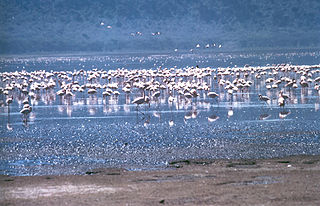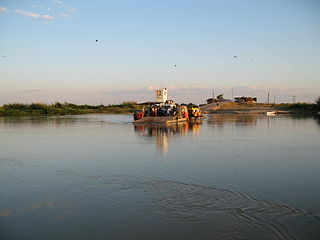
A Wildlife Management Area (WMA) is a protected area set aside for the conservation of wildlife and for recreational activities involving wildlife.

A Wildlife Management Area (WMA) is a protected area set aside for the conservation of wildlife and for recreational activities involving wildlife.
In the United States, WMAs exist in the following states:
In Papua New Guinea a Wildlife Management Area is the simplest form of protected area, that protects an area of land or water while retaining full power to landowners to manage their land. WMAs are managed by an elected committee formed of customary landowners. [25]
List of Wildlife Management Areas in Papua New Guinea:
The Community Wildlife Management Areas Consortium (CWMAC) is an umbrella organization for all other organizations in Tanzania. [26] As of 2016 there are 22 WMA's that have received "Authorized Association" (AA) status out of a total of 38 that have been established or gazetted. WMA's include:

Tanzania comprises many lakes, national parks, and Africa's highest point, Mount Kilimanjaro. Northeast Tanzania is mountainous, while the central area is part of a large plateau covered in grasslands. The country also contains the southern portion of Lake Victoria on its northern border with Uganda and Kenya.

The Rift Valley lakes are a series of lakes in the East African Rift valley that runs through eastern Africa from Ethiopia in the north to Malawi in the south, and includes the African Great Lakes in the south. These include some of the world's oldest lakes, deepest lakes, largest lakes by area, and largest lakes by volume. Many are freshwater ecoregions of great biodiversity, while others are alkaline "soda lakes" supporting highly specialised organisms.

Kilimanjaro National Park is a Tanzanian national park, located 300 kilometres (190 mi) south of the equator and in Kilimanjaro Region, Tanzania. The park is located near the city of Moshi. The park includes the whole of Mount Kilimanjaro above the tree line and the surrounding montane forest belt above 1,820 metres (5,970 ft). It covers an area of 1,688 square kilometres (652 sq mi), 2°50'–3°10'S latitude, 37°10'–37°40'E longitude. The park is administered by the Tanzania National Parks Authority (TANAPA).

Mount Bosavi is a mountain in the Southern Highlands province, Papua New Guinea. It is the collapsed cone of an extinct volcano on the Great Papuan Plateau, part of the Kikori River basin. The crater is approximately 4 km wide and 1 km deep; it is home to a number of endemic species.

Havens Wildlife Management Area is a 7,190-acre (29.1 km2) Wildlife Management Area in Roanoke County, Virginia. Located in the Appalachian Highlands and occupying a part of Fort Lewis Mountain, it is steep and generally inaccessible; elevations in the area range from 1,500 to 3,200 feet above sea level. Save for a few intermittent streams and watering holes created for wildlife, there is little water present; in addition, the area's soils are generally shallow and poor. The area was previously used for timber production, and today hosts a mixture of oaks, hickories, and pine.

Highland Wildlife Management Area is a 14,283-acre Wildlife Management Area in Highland County, Virginia. It consists of three separate tracts of land, centered on Jack Mountain, Bullpasture Mountain, and Little Doe Hill; elevations in the area range from 1,800 to 4,390 feet above sea level.

Pettigrew Wildlife Management Area is a 934-acre (3.78 km2) Wildlife Management Area (WMA) in Caroline County, Virginia. Most of the long and narrow area's land was once part of Fort A. P. Hill. It is largely dominated by forests, including hardwood stands dominated by oak and beech, as well as stands consisting mostly of Virginia and loblolly pine. Lower vegetation including greenbriar, honeysuckle, and Virginia creeper may be seen reclaiming the property's formerly open areas. On the southern edge of the area lies Mount Creek; its drainage, aided by beavers, is the primary wetland for the area. Ware Creek, at the north end, is another major water source, and the tributaries of both streams may also be seen on the property.

Princess Anne Wildlife Management Area is a 1,546-acre (6.26 km2) Wildlife Management Area (WMA) in Virginia Beach, Virginia. The area comprises four tracts; the Beasely, Trojan, and Whitehurst tracts are located on the western shore of Back Bay, separated from the Atlantic Ocean by False Cape, while the Pocahontas Tract, consisting of a number of marshy islands, is at the south end of the bay. A variety of natural communities may be found on all tracts, and water levels are manipulated to help promote the growth of food for waterfowl that migrate and overwinter in the area.

Rapidan Wildlife Management Area is a 10,326-acre (41.79 km2) Wildlife Management Area (WMA) in Madison and Greene counties, Virginia. It is composed of eight separate tracts of land along the eastern slope of the Blue Ridge Mountains; four of these adjoin Shenandoah National Park, and combined they share 25 miles (40 km) of boundary.

G. Richard Thompson Wildlife Management Area, one of the richest botanical areas of Virginia's Blue Ridge Mountains, is a 4,000-acre (16 km2) Wildlife Management Area (WMA) located primarily in Fauquier County, Virginia, with small encroachments into both Warren and Clarke counties.

The Ulanga River, also known as the Kilombero River, is a river that starts in the southwest of Tanzania on the eastern slope of the East African Rift that flows northeast into the Rufiji River then to the Indian Ocean.

Tanzania contains some 20 percent of the species of Africa’s large mammal population, found across its reserves, conservation areas, marine parks, and 17 national parks, spread over an area of more than 42,000 square kilometres (16,000 sq mi) and forming approximately 38 percent of the country's territory. Wildlife resources of Tanzania are described as "without parallel in Africa" and "the prime game viewing country". Serengeti National Park, the country's second largest national park area at 14,763 square kilometres (5,700 sq mi), is located in northern Tanzania and is famous for its extensive migratory herds of wildebeests and zebra while also having the reputation as one of the great natural wonders of the world. The Ngorongoro Conservation Area, established in 1959, is a UNESCO World Heritage Site and inhabited by the Maasai people. Its Ngorongoro Crater is the largest intact caldera in the world.

Lake Jipe is an inter-territorial lake straddling the borders of Kenya and Tanzania. On the Kenyan side, it is located south of the village of Nghonji while on the Tanzanian side, it is situated within Mwanga District, in Kilimanjaro Region. The lake is fed mainly by the Lumi River, which descends from Mount Kilimanjaro, as well as streams from the North Pare Mountains, being on the leeward side. The lake's outlet forms the Ruvu River. Kenya's unfenced Tsavo West National Park protects part of the lake's northern shore, while on the Tanzania side Mkomazi Game Reserve is nearby. The lake is known for its endemic fish, as well as water birds, mammals, wetland plants and lake-edge swamps, which can extend 2 kilometres (1.2 mi) from Jipe's shore.

Banhine National Park is a protected area in northern Gaza Province, Mozambique. The park was established on 26 June 1973. In 2013 the limits of Park were updated to better reflect the realities on the ground, particularly the human presence in the area.

Farragut Wildlife Management Area at 1,405 acres (5.69 km2) is an Idaho wildlife management area in Kootenai County that borders Farragut State Park. The area was formerly the Farragut Naval Training Station established in 1942 and decommissioned in 1946. The land was acquired by the Idaho Department of Fish and Game in 1949.

Ulanga District is one of the six districts of the Morogoro Region of Tanzania. the administrative seat is in Mahenge. It covers 24,460 square kilometres (9,444 sq mi) of which 4,927 square kilometres (1,902 sq mi) is in forest reserves. Ulanga District is bordered to the north and west by the Kilombero District, to the east by the Lindi Region and to the south by the Ruvuma Region.

The Tanzania National Parks Authority commonly known as TANAPA is responsible for the management of Tanzania's national parks. TANAPA is a parastatal corporation and all its income is reinvested into the organization. It is governed by a number of instruments including the National Parks Act, Chapter 282 of the 2002 and the Wildlife Conservation Act No. 5 of 2009. TANAPA manages the nation's 22 National parks which covers approximately 15% of the land area and has the mandate to conserve and manage the wildlife in Tanzania, and to enforce the related laws and regulations in this industry. It manages the biodiversity of the country, protecting and conserving the flora and fauna. The organization does not have a mandate over the game reserves such as the Selous Game Reserve which is managed by the Tanzanian Wildlife Division and the Ngorongoro Conservation Area managed by the Ngorongoro Conservation Authority.

Virginia Wildlife Management Areas (WMAs) are state-managed protected areas that exist primarily for the benefit of wildlife. Within the Commonwealth of Virginia, 41 tracts of land have been protected as WMAs, covering a total of over 203,000 acres. They are managed and maintained by the Virginia Department of Game and Inland Fisheries.

Smith Mountain Cooperative Wildlife Management Area is a 4,996-acre (20.22 km2) Wildlife Management Area (WMA) in Bedford and Pittsylvania counties, Virginia. Located on the shores of Smith Mountain Lake, the WMA is owned by Appalachian Power and cooperatively managed by the Virginia Department of Game and Inland Fisheries and the Virginia Outdoors Foundation through a conservation easement that permits public access.